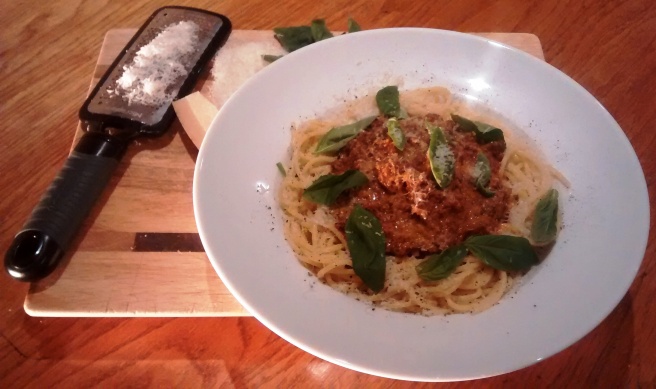
Spag Bol? Are you serious?
Your first post on your shiny new food blog and you choose a recipe that everyone already knows and that has been so widely abused by cooks worldwide that by 1982 the Palazzo della Mercanzia (Bologna Chamber of Commerce) felt moved to ask the Accademia Italiana della Cucina (Italian Academy of Cuisine) to have the official recipe notarised for posterity?
Well, yes. It was always going to be this way. You see Spag Bol has an abiding and unshakable place in my heart.
Firstly, when I was growing up my mother did the vast majority of cooking in our household, and was (and continues to be) excellent at it. I continue to be stunned by her ability to create a brilliant meal out of the most meagre of pickings – she can quite literally turn a pig’s ear into a silk purse.
My father on the other hand was an occasional weekend cook, and when he cooked it was serious business, an event. He would be in the kitchen for hours; it was a place of high drama and serious focus. But the end results were great! I vividly remember his repertoire of Spaghetti Bolognese, Chicken Curry and Seafood Pizza with huge pleasure and joyful nostalgia.
So Spag Bol is intrinsically linked with happy childhood memories.
Secondly, when I was 16 I traveled to rural Belgium for a summer to work in a small village café in the Ardennes. One of my jobs was to prep the solitary dish that we offered up to patrons each day, which quite frequently was Spag Bol. I have never forgotten serving up that first bowl to a customer…and being stunned that not only did they finish the lot, they actually paid for it. Something I had cooked was deemed not only worthy of consumption but a financial transaction!
A lifelong love affair with cooking was born.
Since then I have been perfecting a recipe for my perfect Spag Bol. It is in no way authentic, this is not an Italian dish; it is a complete bastardisation of the original recipe and no doubt a great insult to the good people of Bologna.
My Spag Bol (as the name suggests) must be served with Spaghetti not Tagliatelle, Pappardelle or any other sauce-appropriate pasta. The sauce is not to be mixed in with the pasta prior to plating.
Any of this would ruin the memory of this dish and in doing so a great deal of the pleasure of eating it.
This is my recipe. It makes me happy; I hope it does you too.
Recipe
Cooking time: 2-3 hours
Serves: 6-8 portions
INGREDIENTS
2 Tbsp Olive oil
400g Coarse minced beef
400g Coarse minced pork
200g Coarse minced veal
200g Pancetta or bacon lardons
200g Duck livers (chicken livers are fine)
2 Small onions or one large
2 Carrots
2 Celery ribs
250g Mushrooms (Portobello, portabellini or flat are good)
3 Garlic Cloves
8 Preserved anchovy fillets
1 Tbsp Sun-dried tomato paste
2 Tins of best quality whole tomatoes (I use Cherry or Plum)
1 Tbsp Worcestershire sauce
1 Tbsp Mushroom Ketchup
1 Tsp Sugar
400ml Dry white wine
400ml Whole milk (and a little extra for soaking duck livers)
300ml Beef stock (A stockpot/cube is fine, but go fresh if you have some to hand)
2 Bay leaves
2 Star anise
1 Tbsp Fennel seeds
1 Tbsp Whole black peppercorns
1 Tbsp Red wine vinegar
Salt to taste
For the pasta: 100-150g spaghetti per person
For garnish: Extra virgin olive oil, finely grated Parmesan, fresh basil leaves and ground black pepper.
METHOD
An hour before you wish to cook place your duck or chicken livers in a shallow bowl and submerge in a little milk. This step isn’t strictly necessary but I do think it rounds out the flavour of the livers a little.
When ready to cook get your pans ready, I favour a two pan method for this recipe. A 30 cm Le Creuset round casserole pan and a heavy bottomed frying pan.
Set your large casserole pan over a low heat/flame with a tbsp of olive oil. When the oil comes to temperature add the finely diced pancetta or lardons to the pan and fry till golden.
Finely dice the onion, carrot and celery and add to the pancetta, soften gently for 10 minutes. After this time crush the garlic cloves and add to the pan along with the anchovies, star anise, bay leaves and continue to cook for 5 mins over a low heat.
Coarsely crush the fennel seeds and black peppercorns and add to the pan along with the tomato puree, stir well and continue to cook for a further 5 mins.
Add half (200ml) of the wine and increase the heat under the pan until the wine has been reduced by half. Lower the heat and add the tinned tomatoes, stir well cover and leave at a gentle simmer.
Now move over to the frying pan, preheat on a medium high heat, once at temperature add the remaining tbsp of olive oil, slice the mushrooms into 2cm chunks and add to the pan with a pinch of salt, agitate the pan once to distribute the oil evenly and then leave. Resist the temptation to stir, we are looking for a little caramelisation. Flip the mushrooms once and when they have good colour, add to to the main casserole.
Repeat this exercise with the minced beef, pork and veal, frying in 3 batches, breaking up the mince as it fries with the back of a wooden spoon. Once again try not to stir too much, colour and caramelisation is good. If the meat is sticking too much add a little more olive oil and/or reduce the heat slightly. Add each batch of mince to the main casserole.
Next remove your duck/chicken livers from their milk bath, pat dry with kitchen paper and place on a chopping board. Trim any membrane or connective tissue and discard. Now with a cleaver or large knife mince the livers as finely as you can on the board, it should only take a minute or so.
Once your livers are minced return the frying pan to a medium high heat and add your livers. These can be stirred frequently as they fry and will only take 30-45 seconds. Add these to the main casserole.
Return your frying pan to the heat and add the remaining half (200ml) of wine. Scrape the bottom of the pan with a wooden spoon as the wine reduces, releasing all of the residual fond created during the frying process. Once reduced by half add the wine to the casserole.
Give the casserole a good stir, the tomatoes should be broken up by this point, if not encourage them by crushing them against the side of the pan with the back of a wooden spoon.
Add the stock, a small pinch of salt, the sugar, mushroom ketchup, Worcestershire sauce and 3/4 of the milk (300ml) to the pan, stir well, bring to a very gentle simmer and partially cover with the lid.
Simmer for a minimum of 90 mins, preferably 2-3 hours stirring occasionally to prevent sticking. Add a little water from time to time if it is looking too dry, but over a low heat you should be fine.
When you are nearly ready to serve cook the Spaghetti according to packet instructions until al dente. During this time remove the bay leaves and star anise from the Bolognese, add the final 1/4 of the milk (100ml) to the casserole along with red wine vinegar, stir and simmer until the pasta done. Check the seasoning of the Bolognese and adjust accordingly.
Plate your Spag Bol in the classic British 70’s style as pictured above (or mix together an appropriate amount of the Bolognese sauce into the pasta if you must) and garnish with a drizzle of extra virgin olive oil, a generous handful of finely grated Parmesan, fresh basil leaves and a good grind of black pepper.
Enjoy!

Can’t wait to try this one!
LikeLike
I can’t wait to try this. Having lived in Belgium and Holland for about a year, I was endlessly fascinated by this item being on nearly every menu in every restaurant in Belgium–as common as burgers are in the US. And it’s amazing! Nothing beats a layer of bolognese so thick it can’t possibly sink into the pasta—and the flavour! When done right, it’s a very complex palette. No, it’s not Italian. It’s something on its own, and I have missed it since being back in the states.
LikeLike